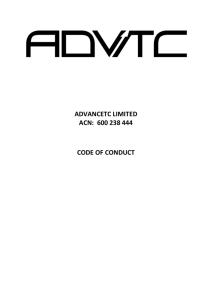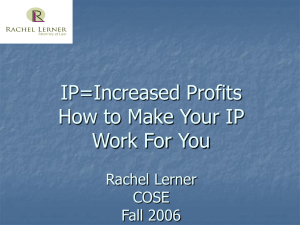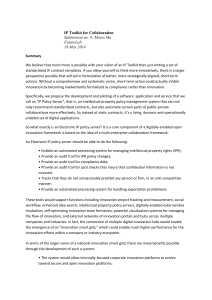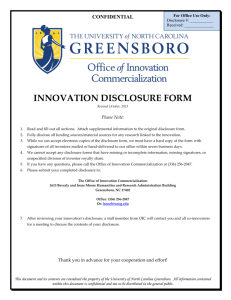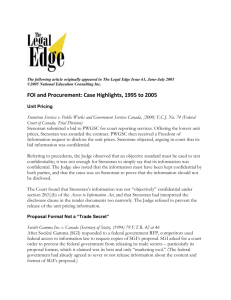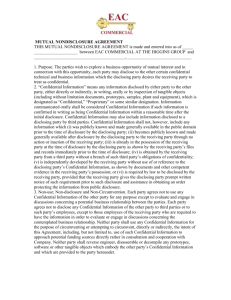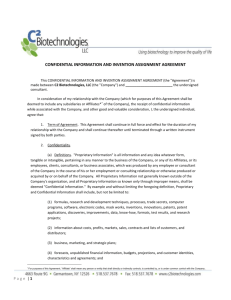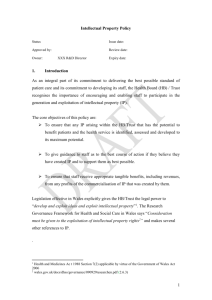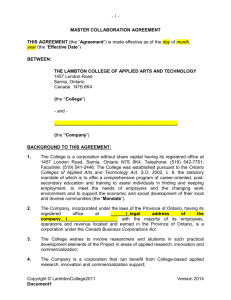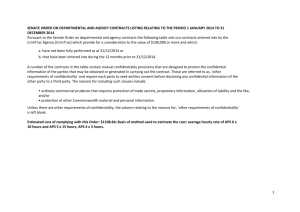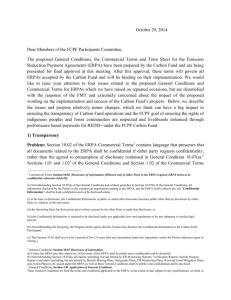Intellectual Property Disclosure Form
advertisement
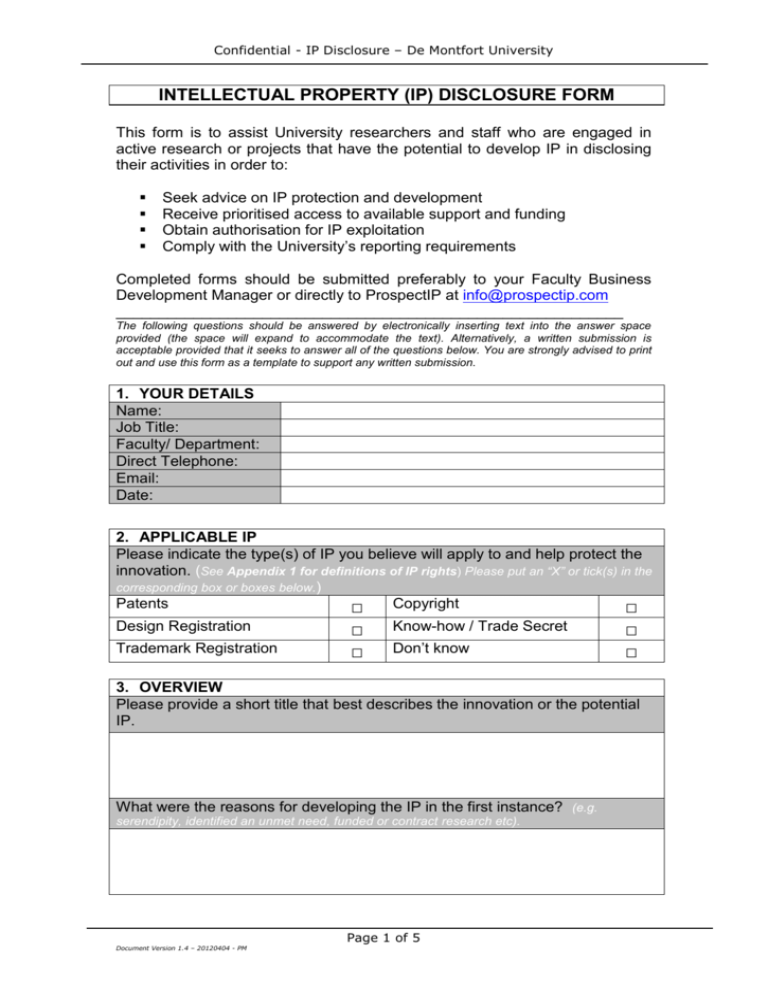
Confidential - IP Disclosure – De Montfort University INTELLECTUAL PROPERTY (IP) DISCLOSURE FORM This form is to assist University researchers and staff who are engaged in active research or projects that have the potential to develop IP in disclosing their activities in order to: Seek advice on IP protection and development Receive prioritised access to available support and funding Obtain authorisation for IP exploitation Comply with the University’s reporting requirements Completed forms should be submitted preferably to your Faculty Business Development Manager or directly to ProspectIP at info@prospectip.com ___________________________________________________________ The following questions should be answered by electronically inserting text into the answer space provided (the space will expand to accommodate the text). Alternatively, a written submission is acceptable provided that it seeks to answer all of the questions below. You are strongly advised to print out and use this form as a template to support any written submission. 1. YOUR DETAILS Name: Job Title: Faculty/ Department: Direct Telephone: Email: Date: 2. APPLICABLE IP Please indicate the type(s) of IP you believe will apply to and help protect the innovation. (See Appendix 1 for definitions of IP rights) Please put an “X” or tick(s) in the corresponding box or boxes below.) Patents □ Copyright □ Design Registration Trademark Registration □ □ Know-how / Trade Secret Don’t know □ □ 3. OVERVIEW Please provide a short title that best describes the innovation or the potential IP. What were the reasons for developing the IP in the first instance? (e.g. serendipity, identified an unmet need, funded or contract research etc). Document Version 1.4 – 20120404 - PM Page 1 of 5 Confidential - IP Disclosure – De Montfort University Please detail the main benefits / advantages and purpose of the innovation and any IP? (e.g. technical innovation, greater efficiency, cost saving etc). Please indicate, where possible, to whom the benefits would be of interest. (e.g. end users, supply chain participants, manufacturers in the case of process based innovation etc). Note benefits include enhanced research status, societal benefits, environmental impacts etc. Are you aware of any competing innovations, products, services or relevant research which makes available or discloses similar innovations? If yes, please provide details. Please identify any existing IP, products or services of relevance. 4. OWNERSHIP Has the IP been wholly developed by you and by the University? If not, please give details of any persons who contributed to the creation of the IP, their organisational affiliations and outline the nature of their involvement. Did the IP result from a specific funding arrangement (e.g. contract for services, research grant, industry collaboration, etc)? If yes, please provide details of the funding body and details of any funding arrangements including details/copies where possible of any legal contracts in place. Please highlight any University facilities or resources which have been used to create the IP. (e.g. laboratory resource, computing resource, bought out staff etc.) Are you aware of any pre-existing IP used in creating the new IP? If yes, please provide details. If no, has this to your knowledge been appropriately investigated? 5. COMMERCIAL DEMAND Please highlight to the best of your knowledge the general markets or industry sectors where the IP could be exploited or commercialised. Document Version 1.4 – 20120404 - PM Page 2 of 5 Confidential - IP Disclosure – De Montfort University Do you have any idea or direct evidence of the potential market size or commercial interest in the IP? Please provide any details in relations to known market factors such as volumes, unit sales potential, nature and number of customers etc. Also detail any commercial enquiries from interested parties, project partners etc. Do you have any initial thoughts or business plans outlining how you envisage the IP being exploited? (e.g. IP licensing, further research, new company formation, IP sale, own manufacture etc.) Please provide a copy of any available business plans. 6. RISKS/BENEFITS Can you identify any potential technical, or similar, risks associated with the further development of the IP? If yes, please provide details. In the case of patentable IP and inventions please completed Section 7 otherwise skip to Section 8. If you are in any doubt about completing Section 7 please contact your BDM or ProspectIP for initial advice. 7. PATENT PROTECTION Have confidential recording and reporting procedures been followed in the course of the development of the IP? (e.g. use of non-disclosure agreements, the IP has not been published or exhibited etc.) If the IP has been disclosed in any form not subject to confidentiality please provide details of to whom and when. (e.g. marketing, publications, exhibitions, demonstrations, conference presentations, discussions with any third parties.) For IP with patent potential, have you conducted a patent search using relevant databases? European Patent Office http://gb.espacenet.com Document Version 1.4 – 20120404 - PM Page 3 of 5 Confidential - IP Disclosure – De Montfort University World Intellectual Property Organisation database Www.wipo.org The United States patent and trade mark database Www.uspto.gov If yes, please provide details of any competing patent IP you have found. Does the disclosure relate to a patent application already in progress, represent a development of the University’s existing patents (granted or otherwise), or is based on any known background IP? If yes, please provide details. 8. SIGNATURES Inventor(s) signature: Print Name: Co-inventor(s) signature: Print Name: Completed forms should be submitted preferably to your Faculty Business Development Manager or directly to ProspectIP at info@prospectip.com Document Version 1.4 – 20120404 - PM Page 4 of 5 Confidential - IP Disclosure – De Montfort University Appendix 1 Main Types of Intellectual Property Includes the following rights recognised by UK law: 1. Patents registered or registrable under the Patents Act 1977. 2. Designs registered under the Registered Designs Act 1949. 3. Trade marks registered or registrable under the Trade Marks Act 1994. 4. Copyright protected under the Copyright Act 1911. 5. Confidential information including secrets arising from an unpatented invention. 6. Other rights resulting from intellectual activity in the industrial, commercial, scientific, literary and artistic fields. The most usual forms of protection that will generate IP are: Patents: provide time-limited monopolies over commercial exploitation of inventions or innovations that have acceptable degrees of novelty, usefulness and appropriateness. These require strict formal registration procedures, and engender costs that can not only be quite high but also outside the core funding activities of government agencies. Particular care must be taken with respect to prior use or public disclosure of the invention or innovation. Design: protects the appearance of products, has both registered and unregistered rights. Registration has associated costs. Trademark: something that is used to distinguish goods and services of one trader from those of another. Must be registered and has associated costs. Copyright: protects the original expression of ideas (not the ideas themselves). This includes written works, internet and multimedia presentations, computer software, business management systems, etc. It is automatic, whether explicitly claimed or not, and is free of charge. Trade secret: proprietary knowledge (know-how) and other confidential information. Is non-registrable and has no direct cost but is of limited application. Document Version 1.4 – 20120404 - PM Page 5 of 5


